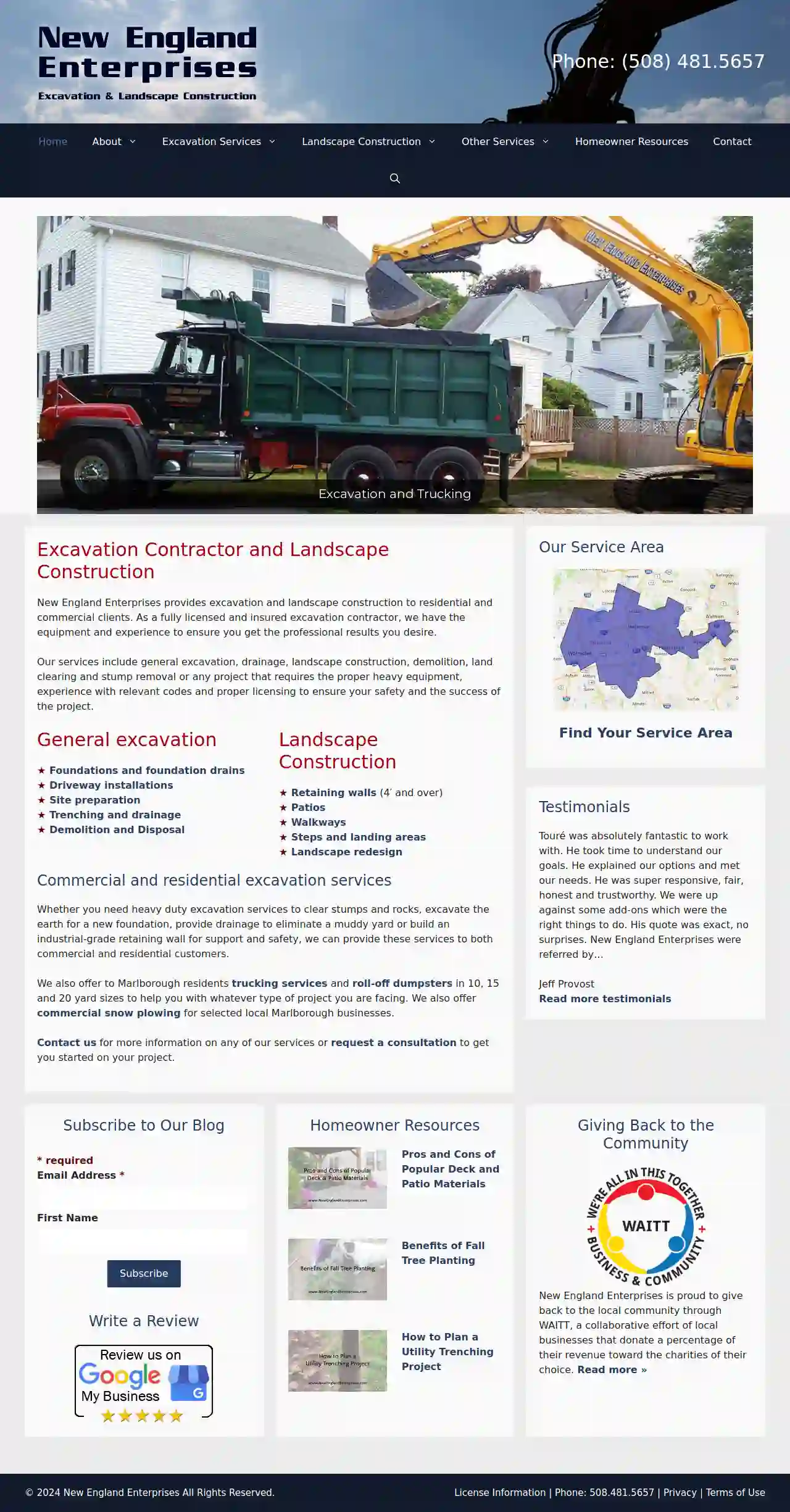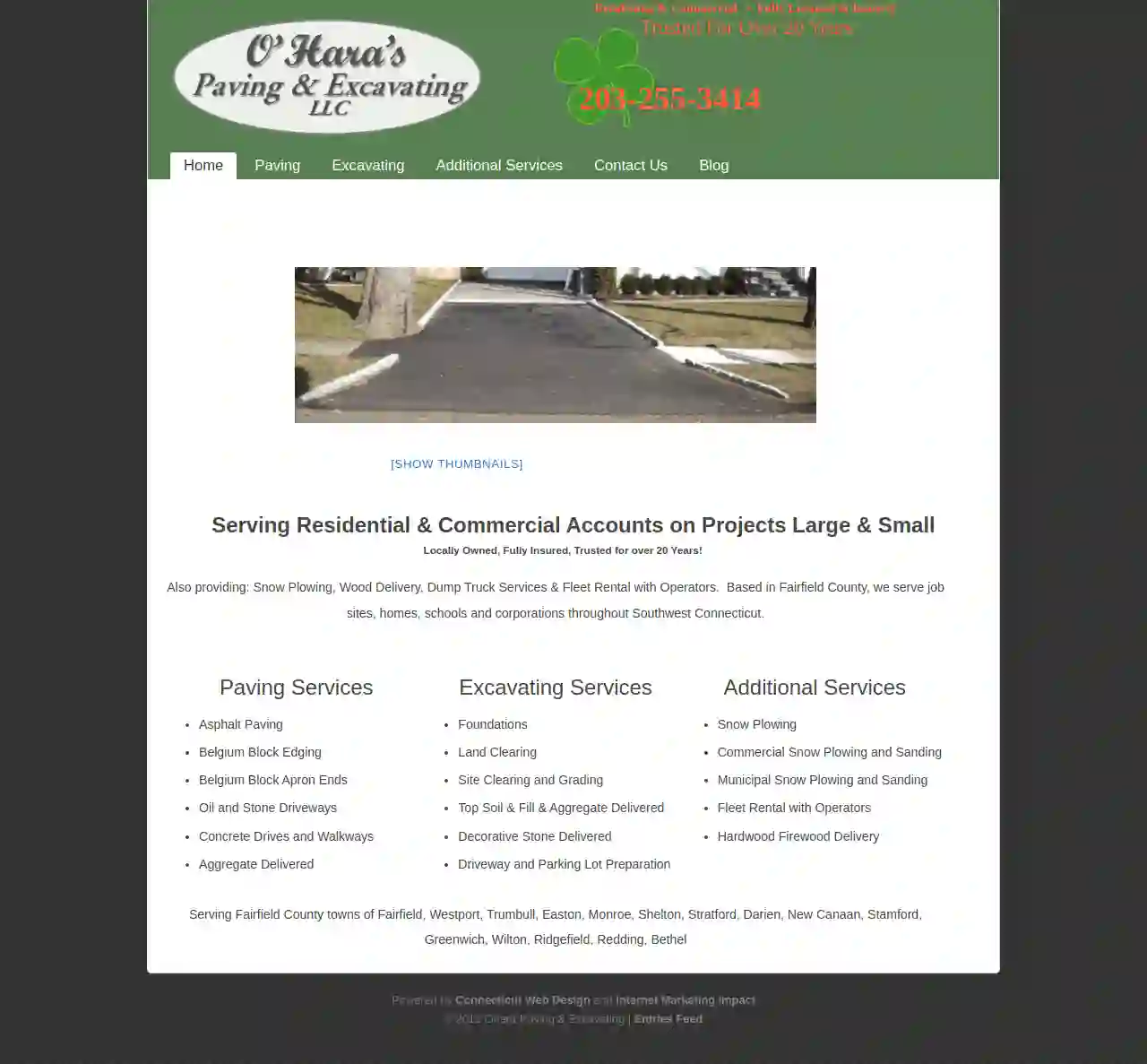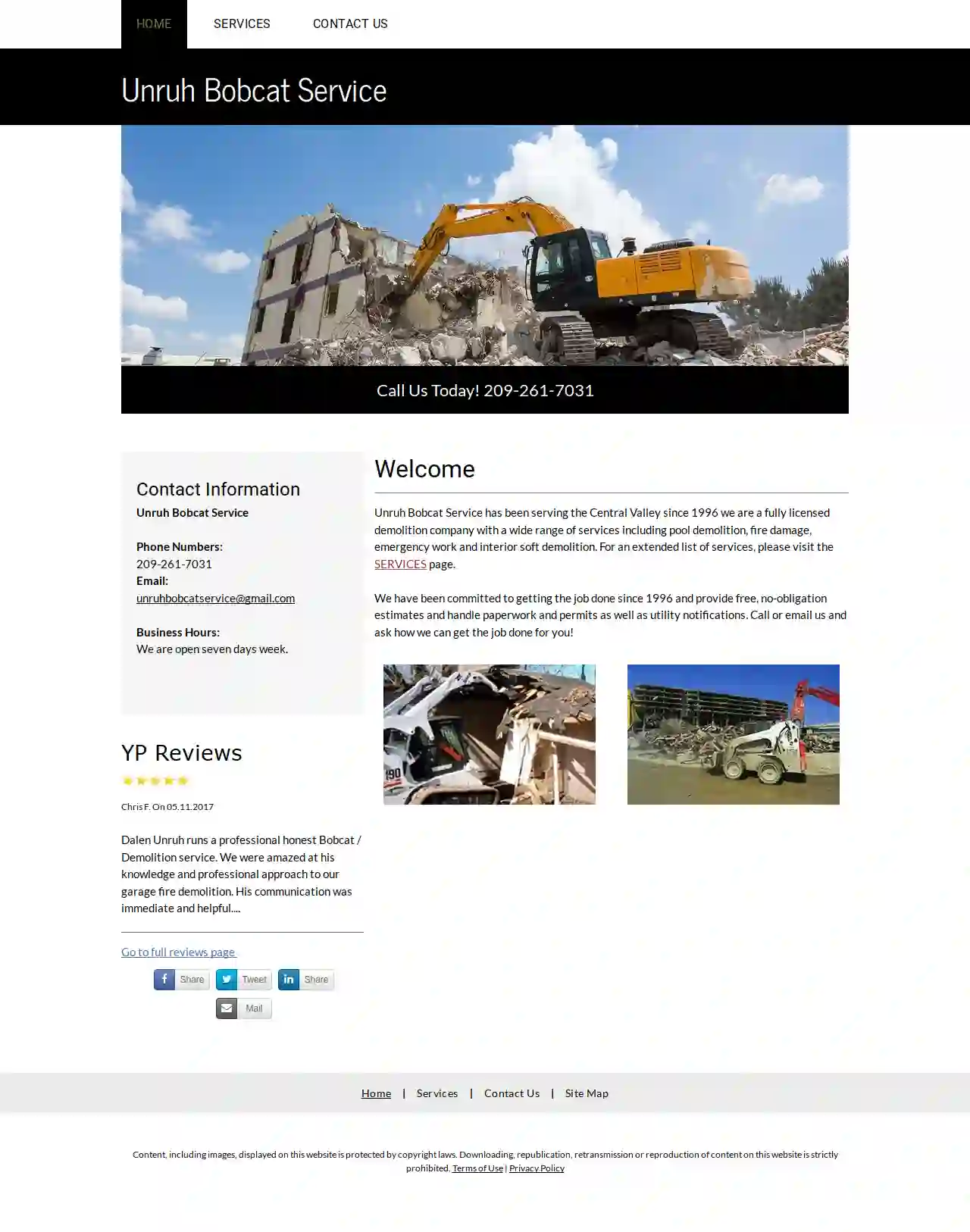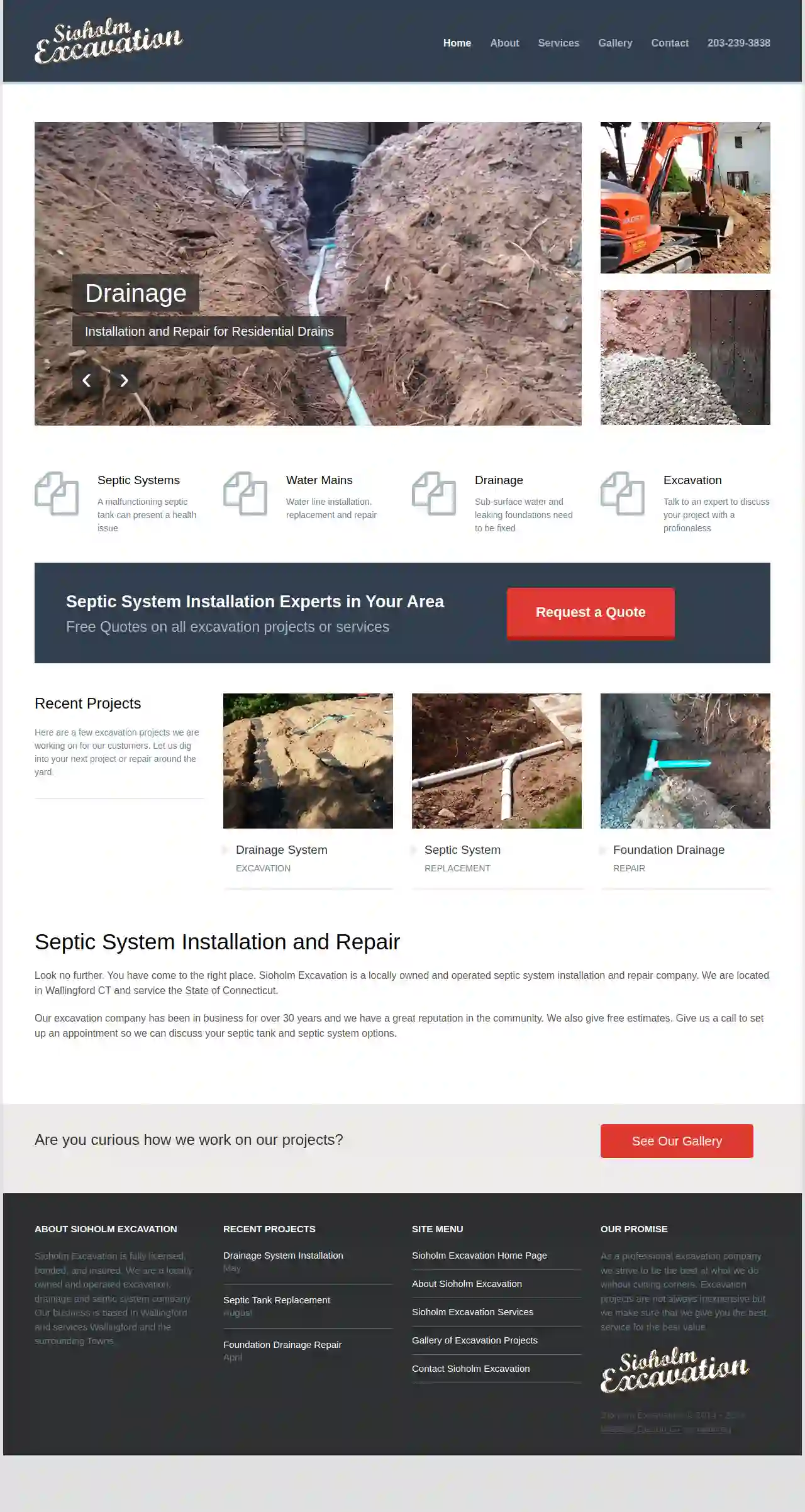Excavation Contractors Rockingham
Find the best Land Excavation in Rockingham
Receive 3 FREE Land Excavation quotes for your project today! Compare profiles, reviews, accreditations, portfolio, etc... and choose the best service.

New England Enterprises
510 reviewsPlymouth, USExcavation Contractor and Landscape Construction New England Enterprises provides excavation and landscape construction to residential and commercial clients. As a fully licensed and insured excavation contractor, we have the equipment and experience to ensure you get the professional results you desire. Our services include general excavation, drainage, landscape construction, demolition, land clearing and stump removal or any project that requires the proper heavy equipment, experience with relevant codes and proper licensing to ensure your safety and the success of the project. Whether you need heavy duty excavation services to clear stumps and rocks, excavate the earth for a new foundation, provide drainage to eliminate a muddy yard or build an industrial-grade retaining wall for support and safety, we can provide these services to both commercial and residential customers. We also offer to Marlborough residents trucking services and roll-off dumpsters in 10, 15 and 20 yard sizes to help you with whatever type of project you are facing. We also offer commercial snow plowing for selected local Marlborough businesses. Contact us for more information on any of our services or request a consultation to get you started on your project.
- Services
- Why Us?
- Testimonials
- Gallery
Get Quote
Consigli Construction Co Inc
4.720 reviews100 Cummings Center, Suite 2200, Beverly, USOur Story A history rooted in tradition, a future led with vision. Learn More > Who We Are A fourth generation company founded in 1905, Consigli offers the strength and stability of a large construction manager and the flexibility of a start-up. Our people love what they do and it shows—in their entrepreneurial spirit, in their desire to create environments that strengthen our communities, in the enduring relationships they build and in the pride they take in their craft. A Legacy Built on Accountability Consigli was founded upon the principles of dedication, hard work and commitment to craft. As we evolve, these things will never change. See the Story > Our People, Our Difference We don’t just assign people to projects—we challenge them to learn, lead, teach, problem-solve and rise to every occasion. Meet the People Who Make It Work > Projects That Move Us It’s our purpose to be builders—it’s ingrained in who we are. We create environments and relationships that strengthen our communities and enrich the ways people live, work, learn, heal and play. Let’s Get to Work >
- Services
- Why Us?
- Gallery
Get Quote
O'Hara's Paving & Excavating
Fairfield, USOhara Paving & Excavating Serving Residential & Commercial Accounts on Projects Large & Small Locally Owned, Fully Insured, Trusted for over 20 Years! Also providing: Snow Plowing, Wood Delivery, Dump Truck Services & Fleet Rental with Operators. Based in Fairfield County, we serve job sites, homes, schools and corporations throughout Southwest Connecticut.
- Services
- Why Us?
- Gallery
Get Quote
Unruh Bobcat Service
54 reviewsLawrence, USUnruh Bobcat Service: Your Trusted Demolition Partner in the Central Valley Since 1996, Unruh Bobcat Service has been a leading demolition company in the Central Valley, providing comprehensive and reliable services to both residential and commercial clients. We are fully licensed and insured, ensuring peace of mind and professional execution for every project. Our team of experienced professionals is dedicated to delivering exceptional service and exceeding your expectations. We understand that demolition projects can be complex and disruptive, which is why we prioritize clear communication, meticulous planning, and efficient execution. We handle all aspects of the demolition process, from obtaining permits to managing waste disposal, allowing you to focus on other aspects of your project. Whether you need to demolish a building, remove a pool, clear a site, or handle fire damage, Unruh Bobcat Service is your trusted partner. We offer a wide range of services, including: Building Demolition Pool Demolition Debris Removal Concrete Breaking and Removal Site Clearing Scrap Metal Removal Pad Building Excavating Grading We are committed to providing free, no-obligation estimates and handling all necessary paperwork and permits. Our goal is to make the demolition process as smooth and stress-free as possible for you. Contact us today to discuss your project and learn how Unruh Bobcat Service can help you achieve your goals.
- Services
- Why Us?
- Testimonials
- Gallery
Get Quote
Deloury Construction Co Inc
4.25 reviews100 Burtt Road, Suite G01, Andover, 01810, USTrusted General Contractor and Excavator in Boston, MA The next time you need help with construction, excavation, or demolition services, count on Deloury Industries. Since 1963, our company has been accomplishing the most demanding construction challenges in the state and across our nation, ensuring our commercial and industrial customers meet the ever-changing demands of the marketplace. Why Choose Us? Our company is founded on the values of honest work, community engagement, and continuous improvement. With these values, strong leadership, and the dedication of our highly skilled employees, we've built on our history of success decade after decade. Moreover, we always aim to exceed your expectations in every project facet and bring life to your developments efficiently, safely, and within budget. Hire Us for Your Next Project Let our team make your project the next challenge we overcome. Our reliable, affordable, and trusted company is always ready to handle any of your construction projects. For inquiries about services, contact us and speak with our general contractor. We hope to be of service to you soon! Be Part of Our Team Jumpstart your career with us, and be part of a company that values its workers. Deloury Industries is now hiring truck drivers. To learn more about our career opportunities, get in touch with us.
- Services
- Why Us?
- Gallery
Get Quote
Southbury Land Services LLC
510 reviewsWaterbury, USAbout Us Southbury Land Services is a Connecticut-based company, centrally situated, specializing in excavation, septic systems, and tree removal, all managed and run by a dedicated family team. Who We Are Meet Southbury Land Services. We’re a family-owned company in the heart of Connecticut, founded by Dominic Brown. Our team of experts is dedicated to providing top-notch land services like excavation, septic systems, and tree removal. We focus on building trust with our customers by being transparent and reliable in every job we do. At Southbury Land Services, we’re committed to excellence. We use the latest technology and techniques to ensure high-quality work at affordable prices. Whether it’s digging foundations or maintaining septic systems, we’re here to make your land management needs stress-free and straightforward. Our Dedicated Team We Take Care Of Your Land Services. At Southbury Land Services, we take pride in our dedicated team of experts boasting years of experience in excavation, septic systems, and tree removal. Our professionals are well-versed in the intricacies of these services and are equipped to offer solutions ensuring smooth and efficient completion of your projects. We extend a range of services to meet your needs. We deliver top-notch excavation services, ensuring precise and efficient groundwork for your projects. Our septic systems expertise guarantees optimal installation, maintenance, and repair, ensuring the functionality and longevity of your system.
- Services
- Why Us?
- Gallery
Get Quote
Integrity Construction
53 reviewsDanbury, USWelcome to Integrity Construction Full General Contractor Service with over 23 Years of Experience Based in Danbury, CT, Integrity Construction has built a reputation as providing a superior home remodeling and renovation service at affordable and competitive pricing. We are able to do this because we specialize in what we do, which means we can complete our projects in an efficient and timely manner. We have perfected the process of adding significant value to your most important investment, which is your home. With ample design experience and awareness of the latest interior design trends, we are capable of adding a high level of beauty and functionality in all the important spaces of your home. Our quality interior and exterior remodeling services guarantee a beautiful, long-lasting impact which you your family can enjoy for many years to come. Integrity Construction has been in business for over 23 years in Connecticut. Integrity is involved in every aspect of the project. We perform the inspections, prepare the estimates, and ensure that every aspect of the work is done in the best, most professional, and safest way possible. Our crews are highly trained with a focus on safety. Your property is respected and cared for throughout the entire process. Our goal is satisfying our customers with quality work, completed in a timely manner. At Integrity Construction, we understand that one of your most valuable assets is your home. We also understand that when it comes to the care and maintenance of your home, you want a trusted, reliable, and proven contractor on your side. Integrity Construction is committed to providing the highest quality products, superior workmanship, and professional service to all of our customers. Whether you need a repair, maintenance, or full roof replacement, you’ll find that we have the expertise and experience to get the job done and to do it right, and we are licensed and fully insured. Our excellent reputation speaks for itself. A high percentage of our jobs have been obtained through customer referrals. We service the following towns and surrounding areas in Connecticut; Greenwich, Westport, New Fairfield, New Cannan, Ridgefield, Wilton, Brookfield, Weston, Redding, Easton, and Shermam
- Services
- Why Us?
- Gallery
Get Quote
Sioholm Excavation
48 reviews42 New Place Street, Wallingford, 06492, USAbout Sioholm Excavation Sioholm Excavation is a locally owned and operated excavation, drainage and septic system company. We are fully licensed, bonded, and insured. Our business is based in Wallingford and services Wallingford and the surrounding Towns. Our Promise As a professional excavation company we strive to be the best at what we do without cutting corners. Excavation projects are not always inexpensive but we make sure that we give you the best service for the best value. Experience With over 3 Decades of Excavation Experience, let Sioholm Excavation help you with your installation or repairs for your home or business. Throughout the years, Sioholm Excavation has helped hundreds of customers fix their septic systems, sewer, water main, drainage and other issues as quickly as possible for a fair price. We take pride helping customers as quickly and efficiently as possible. Services Sioholm Excavation Services offers high quality installations and repairs on all types of excavation and site projects. With professional service, Sioholm Excavation is a company with years of experience who takes pride in each and every job while providing exceptional customer service. Being able to provide residential and commercial excavation services throughout Connecticut, Sioholm Excavation can work with your contractors for new construction or help you with your repairs. From septic systems to all types of property drainage, we are the number one choice for your excavation services and we will provide FREE estimates to help you figure out what your project will cost. We also can help recommend excavation solutions for certain types of problems so you can insure a complete job that works. Sioholm Excavation is committed to helping homeowners and businesses with all of their excavations needs. Professional service and quality workmanship, Sioholm Excavation is ready for your next project. Teamwork Our company is experienced in collaboratively working with all parties involved in a given project, including the homeowner, developer, general contractor, site and professional engineers, and other subcontractors. Testimonials SIoholm Excavation was there to help us get our septic system replaced right away. There is nothing worse than having no control over your water and septic system, and Bill Sioholm was there to help us get back on track. Wallingford Resident Values We pride ourselves on our honest and dependable services giving you trusted, high quality workmanship and the personal attention you deserve. Professional Dependable Courteous Experienced Knowledgeable
- Services
- Why Us?
- Testimonials
- Gallery
Get Quote
Excavation Plus Inc
48 reviews85 Bethany Rd, Monson, 01057, USExcavation Plus Excavation Plus is a trusted name in the Monson, MA area, known for our quality work, reliability, and exceptional service. We specialize in a wide range of services, including septic system installations, house site excavation, sewer and water installations, demolition, drainage work, small road extensions, commercial snow plowing, and sanding. Our Services We are committed to providing our clients with the highest quality workmanship and customer service. Our team of experienced professionals is dedicated to completing your project on time and within budget. We are fully licensed and insured, and we are proud to be a member of the Better Business Bureau.
- Services
- Why Us?
- Gallery
Get Quote
Epic Excavation & Contracting
Brewster, New York, United States, USAbout Us EPIC Contracting is a premier provider of all phases of excavation and general contracting services. Here at EPIC Contracting we provide and manage all types of projects, from residential and commercial excavation services to building your dream home and other home renovation services. With our precision attention to detail and our years of expertise, let EPIC Contracting handle the job and leave you with EPIC results. GENERAL CONTRACTING SERVICES EPIC Contracting is a premier provider of all phases of excavation and general contracting services. Here at EPIC Contracting we provide and manage all types of projects, from residential and commercial excavation services to building your dream home and other home renovation services. With our precision attention to detail and our years of expertise, let EPIC Contracting handle the job and leave you with EPIC results. EXCAVATION SERVICES EPIC Contracting is a premier provider of all phases of excavation and general contracting services. Here at EPIC Contracting we provide and manage all types of projects, from residential and commercial excavation services to building your dream home and other home renovation services. With our precision attention to detail and our years of expertise, let EPIC Contracting handle the job and leave you with EPIC results.
- Services
- Why Us?
- Gallery
Get Quote
Over 22,076+ Excavation Companies registered
Our excavation companies operate in Rockingham and beyond!
ExcavationHQ has curated and vetted Top Excavation Pros arround Rockingham. Find a top & trustworthy contractor today.
Frequently Asked Questions About Excavation Contractors
- Sloped Property: Your property has a significant slope, making it prone to soil erosion or landslides.
- Creating Usable Space: You want to level off a sloped area to create a flat surface for patios, gardens, or other outdoor spaces.
- Preventing Damage: Erosion is threatening existing structures, driveways, or walkways.
- Landscaping Features: You're incorporating tiered gardens, raised beds, or other landscaping elements requiring soil retention.
- Clearly Define the Scope: Outline the project's goals, including the excavation area, depth, grade, and intended use.
- Obtain Necessary Permits: Research and acquire any required permits from your local authorities.
- Mark Utility Lines: Contact your utility companies to locate and mark underground utilities to prevent damage.
- Communicate with Neighbors: Inform your neighbors about the project's timeline and potential noise or disruptions.
- Prepare the Site: Clear any obstacles, such as vegetation, furniture, or structures, from the excavation area.
- Discuss Safety Protocols: Review safety procedures with the contractor to ensure a safe work environment.
- Experience: Choose contractors with a proven track record and years of experience in excavation projects similar to yours.
- Licensing and Insurance: Verify that they are properly licensed to operate in your area and carry adequate insurance to protect you from liability in case of accidents or damage.
- Equipment and Resources: Ensure they have the necessary equipment and resources to handle your project efficiently and safely.
- Positive Reviews and References: Check online reviews and testimonials from previous customers. Request references and contact them to inquire about their experience with the contractor.
- Professionalism: Opt for a company that communicates clearly, provides detailed and transparent estimates, and has a responsive and courteous team.
What is the difference between topsoil and subsoil?
Topsoil: The uppermost layer, typically rich in organic matter, nutrients, and microorganisms. It's essential for plant growth and is often darker in color.
Subsoil: The layer beneath the topsoil, containing less organic matter and generally denser. It provides support for roots but is less fertile than topsoil.
During excavation, topsoil is often removed and preserved separately for later use in landscaping, while subsoil is typically used for backfilling or other less demanding applications.
How do I know if I need a retaining wall?
What should I do before excavation starts?
How do I find a good excavation contractor?
What is the difference between topsoil and subsoil?
Topsoil: The uppermost layer, typically rich in organic matter, nutrients, and microorganisms. It's essential for plant growth and is often darker in color.
Subsoil: The layer beneath the topsoil, containing less organic matter and generally denser. It provides support for roots but is less fertile than topsoil.
During excavation, topsoil is often removed and preserved separately for later use in landscaping, while subsoil is typically used for backfilling or other less demanding applications.
How do I know if I need a retaining wall?
- Sloped Property: Your property has a significant slope, making it prone to soil erosion or landslides.
- Creating Usable Space: You want to level off a sloped area to create a flat surface for patios, gardens, or other outdoor spaces.
- Preventing Damage: Erosion is threatening existing structures, driveways, or walkways.
- Landscaping Features: You're incorporating tiered gardens, raised beds, or other landscaping elements requiring soil retention.
What should I do before excavation starts?
- Clearly Define the Scope: Outline the project's goals, including the excavation area, depth, grade, and intended use.
- Obtain Necessary Permits: Research and acquire any required permits from your local authorities.
- Mark Utility Lines: Contact your utility companies to locate and mark underground utilities to prevent damage.
- Communicate with Neighbors: Inform your neighbors about the project's timeline and potential noise or disruptions.
- Prepare the Site: Clear any obstacles, such as vegetation, furniture, or structures, from the excavation area.
- Discuss Safety Protocols: Review safety procedures with the contractor to ensure a safe work environment.
How do I find a good excavation contractor?
- Experience: Choose contractors with a proven track record and years of experience in excavation projects similar to yours.
- Licensing and Insurance: Verify that they are properly licensed to operate in your area and carry adequate insurance to protect you from liability in case of accidents or damage.
- Equipment and Resources: Ensure they have the necessary equipment and resources to handle your project efficiently and safely.
- Positive Reviews and References: Check online reviews and testimonials from previous customers. Request references and contact them to inquire about their experience with the contractor.
- Professionalism: Opt for a company that communicates clearly, provides detailed and transparent estimates, and has a responsive and courteous team.